Washington Park
Topic: Architecture / Chicago
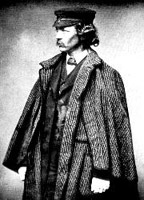
TAKOTRONsemester001 officially ended yesterday as I handed in my paper, "Frederick Law Olmsted and the Democratization of Landscape Theory," at 12:06PM. For the topic I researched the famous American landscape architect in relation to 2 major theoretical movements that directly influenced him, the English Picturesque of the mid to late 18th century, and American transcendentalism of the mid 19th. Both movements were rooted in our experience of rural landscapes, but had elements somewhat contrary to democracy. The Picturesque was put forth by wealthy British gentlemen who created contrived "natural" landscapes for their enormous country estates. Transcendentalism had a strong moral, even theological undertone that enveloped its aesthetic ideas, but it was too introverted and rural to be directly applicable to the urban industrial life that would grow to dominate American society.
Frederick Law Olmsted (right), who was an established social activist before he began designing landscapes, was able to adapt his influences to create a plethora of urban park systems that would serve the surrounding communities democratically. He made it a point to avoid loud details like flower beds, fountains, and symmetrical open squares, instead developing experiential, all-encompassing scenes that would have an "unconscious influence" on visitors. His hope was, and he succeeded, to introduce into our cities "scenery offering the most agreeable contrasts to that of the rest of town; an opportunity for the people to come together for the single purpose of enjoyment, unembarrassed by the limitations with which they are surrounded at home or in the pursuit of their daily avocations."
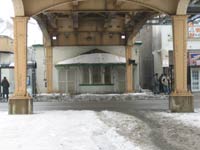
Olmsted's first design was New York's Central Park, planned with architect Calvert Vaux beginning in 1858, and he would go on to design many of the nation's campuses and most treasured parks, among them Brooklyn's Prospect Park, Boston's Jamaica, Fenway, and Franklin Parks, Niagara and Yosemite national parks, and Chicago's southern park system. The last was planned in the 1870s, and would be modified as the site of 1893's World's Columbian Exhibition. The fairgrounds comprised Jackson Park and the Midway Plaisance (where the first Ferris Wheel was featured), which extended West to Washington Park.

So I had turned in this paper and was on my way home when i decided to take the long route and walk through Washington Park. The Green Line drops you off on Garfield Boulevard across the street from the oldest existing original "L" station, from 1892 (left). The area has changed completely since the late 19th century, and the idealistic hope that went into it is difficult to discern. In the 19teens and 20s the neighborhood bordering Washington Park to the west rapidly shifted to African-American and, unfortunately, many of the previous settlers dispersed. Today it remains almost completely African-American (>98%) and is one of Chicago's more impoverished regions, with a median income barely over $15,000 with almost half of its buildings vacant. The area east of Washington Park, called Hyde Park, is a diverse and well-reputed neighborhood, partly because it is home to the University of Chicago.
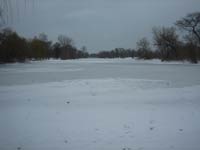
During the surrounding area's demographic changeover, the University made active moves to prevent blacks from settling near Washington Park, and may today be somewhat responsible for the park's function as a sort of buffer zone separating the haves from the have-nots. It is still a beautiful escape from city life, featuring a (frozen) lagoon, a variety of trees, wildlife, bridges, and paths, and is treasured by many different people, including students, locals, school groups, nature-watchers, and even cricket players.
 The Spertus Institute of Jewish Studies is expanding their facilities to what was an adjacent, empty, mid-block site. Krueck & Sexton Architects designed the new building with a prominent faceted glass frontage. The design is in the contemporary "funky-form" vein (led by people like Daniel Liebeskind and Zaha Hadid), in that it makes use of engineering to create a sculptural form, but there is no architectonic expression in the design. That is, it's not about how it's structure works, but the end result of that structure. Last weekend I walked by and took these shots of the facade being installed. You can see the complicated folded form is put together with a rather simple steel frame extending from the irregular outer edges of the floor slabs.
The Spertus Institute of Jewish Studies is expanding their facilities to what was an adjacent, empty, mid-block site. Krueck & Sexton Architects designed the new building with a prominent faceted glass frontage. The design is in the contemporary "funky-form" vein (led by people like Daniel Liebeskind and Zaha Hadid), in that it makes use of engineering to create a sculptural form, but there is no architectonic expression in the design. That is, it's not about how it's structure works, but the end result of that structure. Last weekend I walked by and took these shots of the facade being installed. You can see the complicated folded form is put together with a rather simple steel frame extending from the irregular outer edges of the floor slabs.  I think the overall effect will make a nice addition to this part of Michigan Avenue. With a narrow mid-block site, it's really only the facade that you have to make an architectural statement, and I think this exploits that notion successfully. According to the Spertus Institute, the forms are reminiscent in proportion and orientation to the windows found along the avenue. And there will be a Kosher Deli! Hell yeah, pickles and pastrami.
I think the overall effect will make a nice addition to this part of Michigan Avenue. With a narrow mid-block site, it's really only the facade that you have to make an architectural statement, and I think this exploits that notion successfully. According to the Spertus Institute, the forms are reminiscent in proportion and orientation to the windows found along the avenue. And there will be a Kosher Deli! Hell yeah, pickles and pastrami.

 There are no right answers, but to get the most out of Mies, it's important to ask all the questions, and I think that's something Jencks does well.
There are no right answers, but to get the most out of Mies, it's important to ask all the questions, and I think that's something Jencks does well.

 I have admired its ramshackled crudeness from the CTA bus many times, but it seems like people are getting pretty sick of it. It is certainly absurd that neither the public, the city, or Metra's own dignity have demanded its replacement. The Tribune article offers explanations about budget delays, and other predictable set-backs. But with the shiny new condos going up around it, I imagine something's going to have to happen soon.
I have admired its ramshackled crudeness from the CTA bus many times, but it seems like people are getting pretty sick of it. It is certainly absurd that neither the public, the city, or Metra's own dignity have demanded its replacement. The Tribune article offers explanations about budget delays, and other predictable set-backs. But with the shiny new condos going up around it, I imagine something's going to have to happen soon.
 When I first passed by the Chicago Board of Trade, I thought I recognized its logo from somewhere. Upon reflection, I realized it is extremely similar to that of Omni Consumer Products (OCP), the sinister corporation that runs Detroit in the 1987 film Robocop. One or two friends confirmed this similarity, so I thought I would investigate.
When I first passed by the Chicago Board of Trade, I thought I recognized its logo from somewhere. Upon reflection, I realized it is extremely similar to that of Omni Consumer Products (OCP), the sinister corporation that runs Detroit in the 1987 film Robocop. One or two friends confirmed this similarity, so I thought I would investigate.  The website
The website  Old news, but a few weeks ago a culturally invaluable and architecturally important church burnt down. Here are some eulogies and testaments to its significance. I knew it was near campus, and finding myself unexpectedly right in front of it one day last week, took a couple pictures.
Old news, but a few weeks ago a culturally invaluable and architecturally important church burnt down. Here are some eulogies and testaments to its significance. I knew it was near campus, and finding myself unexpectedly right in front of it one day last week, took a couple pictures. 

 The new Mac replaces the old Rock 'n' Roll McDonalds, which was filled with airbrushed murals and memorabilia. There is still an on-site (somewhere in the parking lot), stand-alone shrine to the original restaurant, but the new design is glass curtian walls and high-design, featuring a time-line in dioramas of Pop Culture (and Mac culture) relics through the ages. You can eat your burger in the comfort of designer furniture by Mies, Corbusier, and Saarinen while enjoying your favorite post-war decade's memorabilia and music. Chicago architect Helmut Jahn proposed a
The new Mac replaces the old Rock 'n' Roll McDonalds, which was filled with airbrushed murals and memorabilia. There is still an on-site (somewhere in the parking lot), stand-alone shrine to the original restaurant, but the new design is glass curtian walls and high-design, featuring a time-line in dioramas of Pop Culture (and Mac culture) relics through the ages. You can eat your burger in the comfort of designer furniture by Mies, Corbusier, and Saarinen while enjoying your favorite post-war decade's memorabilia and music. Chicago architect Helmut Jahn proposed a 
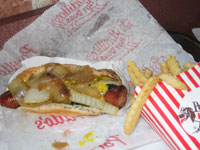



 TAKOTRONsemester001 officially ended yesterday as I handed in my paper, "Frederick Law Olmsted and the Democratization of Landscape Theory," at 12:06PM. For the topic I researched the famous American landscape architect in relation to 2 major theoretical movements that directly influenced him, the English Picturesque of the mid to late 18th century, and American transcendentalism of the mid 19th. Both movements were rooted in our experience of rural landscapes, but had elements somewhat contrary to democracy. The Picturesque was put forth by wealthy British gentlemen who created contrived "natural" landscapes for their enormous country estates. Transcendentalism had a strong moral, even theological undertone that enveloped its aesthetic ideas, but it was too introverted and rural to be directly applicable to the urban industrial life that would grow to dominate American society.
TAKOTRONsemester001 officially ended yesterday as I handed in my paper, "Frederick Law Olmsted and the Democratization of Landscape Theory," at 12:06PM. For the topic I researched the famous American landscape architect in relation to 2 major theoretical movements that directly influenced him, the English Picturesque of the mid to late 18th century, and American transcendentalism of the mid 19th. Both movements were rooted in our experience of rural landscapes, but had elements somewhat contrary to democracy. The Picturesque was put forth by wealthy British gentlemen who created contrived "natural" landscapes for their enormous country estates. Transcendentalism had a strong moral, even theological undertone that enveloped its aesthetic ideas, but it was too introverted and rural to be directly applicable to the urban industrial life that would grow to dominate American society.





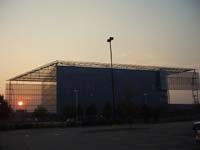
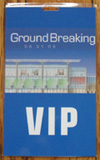 Since our last entry, Architecture Day in Chicago has come and gone. It was a'ight. You know TAKOTRON was V.I.P., cuz we're the CORPORATE SPONSOR of bold expression everywhere. So first up was the groundbreaking ceremony for the Art Institute's new North wing, which should be pretty cool, if they get the funding they need--twice what they have to reach their goal, and everyone knows these things can end up costing a lot more than the original estimate. Renzo Piano designed it, and the plan is to have a bridge leading from Millenium Park to a new entrance with a sculpture terrace on the second or third floor of the new wing. Piano explained that the bridge will be "straight, like a knife," forming a dialogue with Frank Gehry's serpentine titanium-paneled bridge over Columbus drive on the park's east side. The new-ish President and Director of the Art Institute, James Cuno, started off the morning with an optimistic speech on Chicago and the Museum's relationship with one another, and their collective place in the world, or something close to that. From what I've seen, he's intelligent and well spoken and a nice guy. He was followed by an appropriate recitation of an excerpt from Daniel Burnham's Plan of Chicago (1909) and then inevitible speeches by the museum's Board of Trustees and the CEO of JPMORGANCHASEBANKONE, the real corporate sponsor. Yay, mergers. I thought banks were supposed to exhibit an image of stability and permanence. Why do they always merge and buy eachother out, then, and end up with dumb names like JPMORGANCHASE and AMALGAMATED and FIFTHTHIRD? Throughout the whole thing, which involved no actual ground-breaking, the Redmoon Theater had these Spring Nymph people with painted white faces wandering around on stilts with watering cans, sprinkling petals around with branches stuck on their heads. What's up with theater?
Since our last entry, Architecture Day in Chicago has come and gone. It was a'ight. You know TAKOTRON was V.I.P., cuz we're the CORPORATE SPONSOR of bold expression everywhere. So first up was the groundbreaking ceremony for the Art Institute's new North wing, which should be pretty cool, if they get the funding they need--twice what they have to reach their goal, and everyone knows these things can end up costing a lot more than the original estimate. Renzo Piano designed it, and the plan is to have a bridge leading from Millenium Park to a new entrance with a sculpture terrace on the second or third floor of the new wing. Piano explained that the bridge will be "straight, like a knife," forming a dialogue with Frank Gehry's serpentine titanium-paneled bridge over Columbus drive on the park's east side. The new-ish President and Director of the Art Institute, James Cuno, started off the morning with an optimistic speech on Chicago and the Museum's relationship with one another, and their collective place in the world, or something close to that. From what I've seen, he's intelligent and well spoken and a nice guy. He was followed by an appropriate recitation of an excerpt from Daniel Burnham's Plan of Chicago (1909) and then inevitible speeches by the museum's Board of Trustees and the CEO of JPMORGANCHASEBANKONE, the real corporate sponsor. Yay, mergers. I thought banks were supposed to exhibit an image of stability and permanence. Why do they always merge and buy eachother out, then, and end up with dumb names like JPMORGANCHASE and AMALGAMATED and FIFTHTHIRD? Throughout the whole thing, which involved no actual ground-breaking, the Redmoon Theater had these Spring Nymph people with painted white faces wandering around on stilts with watering cans, sprinkling petals around with branches stuck on their heads. What's up with theater? 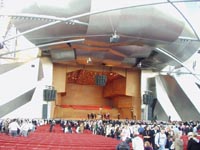
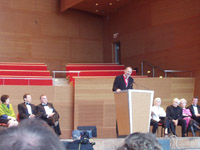 right:(l to r) Victoria Newhouse, architectural historian and author, founder and director of the Architectural History Foundation; Tom Pritzker; The Honorable Archduke Daley; Thom Mayne, at podium; woman in white, oops, forgot her naem; Frank Gehry; Ada Louise Huxtable, author and architecture critic of the Wall Street Journal; another person I forgot, but I think it's the architect Carlos Jimenez
right:(l to r) Victoria Newhouse, architectural historian and author, founder and director of the Architectural History Foundation; Tom Pritzker; The Honorable Archduke Daley; Thom Mayne, at podium; woman in white, oops, forgot her naem; Frank Gehry; Ada Louise Huxtable, author and architecture critic of the Wall Street Journal; another person I forgot, but I think it's the architect Carlos Jimenez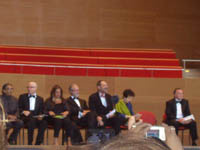 left:(l to r) Balkrishna Vithaldas Doshi, architect, sharp dresser, planner and professor of Architecture from Ahmeddabad, India; Rolf Fehlbaum, charman of the board of Vitra, Basil, Switzerland; Zaha Hadid, last year's Pritzker Laureate; Renzo Piano, 1998 Laureate; Thom Mayne; Victoria Newhouse; Mayor Daley, looking aloof
left:(l to r) Balkrishna Vithaldas Doshi, architect, sharp dresser, planner and professor of Architecture from Ahmeddabad, India; Rolf Fehlbaum, charman of the board of Vitra, Basil, Switzerland; Zaha Hadid, last year's Pritzker Laureate; Renzo Piano, 1998 Laureate; Thom Mayne; Victoria Newhouse; Mayor Daley, looking aloof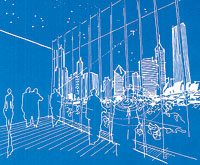 MAY 31 2005 CHICAGO, IL
MAY 31 2005 CHICAGO, IL
 So Trump, self-important asshole, fake-millionaire extraordinaire, is having built a bigass tower by the river here in Chicago. They're already clearing the site and maybe started digging for the foundation (left). It's gonna be yooge or whatever, a grand display of everyday nothingness. Included are "472 super-luxury condominiums from studios to three bedrooms and up to seven bedroom penthouses," and "90,450 square feet with exclusive boutique shopping and fine dining along the River." I am quoting from the official
So Trump, self-important asshole, fake-millionaire extraordinaire, is having built a bigass tower by the river here in Chicago. They're already clearing the site and maybe started digging for the foundation (left). It's gonna be yooge or whatever, a grand display of everyday nothingness. Included are "472 super-luxury condominiums from studios to three bedrooms and up to seven bedroom penthouses," and "90,450 square feet with exclusive boutique shopping and fine dining along the River." I am quoting from the official  According to my copy of the AIA Guide to Chicago (2nd ed.), "Mies last American building, and his largest, follows his familiar model. It is sited so as to avoid obstructing Marina City and to capture the lake views made possible by a jog in the river" (52). Isn't that nice, how it purposefully avoids blocking Bertrand Goldberg's famous "corncob" towers? I hope you don't expect Donald to maintain that sort of reverence. No, looking at that picture I took from his little website (
According to my copy of the AIA Guide to Chicago (2nd ed.), "Mies last American building, and his largest, follows his familiar model. It is sited so as to avoid obstructing Marina City and to capture the lake views made possible by a jog in the river" (52). Isn't that nice, how it purposefully avoids blocking Bertrand Goldberg's famous "corncob" towers? I hope you don't expect Donald to maintain that sort of reverence. No, looking at that picture I took from his little website ( Here is a photo of that model of Mies' original steel design for the Promontory Point Apartments. It looks like this is looking from the west, towards the lake. Lets listen to the song (source:
Here is a photo of that model of Mies' original steel design for the Promontory Point Apartments. It looks like this is looking from the west, towards the lake. Lets listen to the song (source: Several weeks ago we made some comparisons between Mies van der Rohe and his contemporary, Le Corbusier. We also described a connection between his Promontory Apartments and unambitious imitations with different aims, specifically Cabrini Greens. I recently visited the Promontory Apartments, and discovered some impressive qualities not immediately discernable. We are so accustomed to Mies' imitators that it sometimes takes some effort or closer observation to understand his true innovation (I would say 'genius,' but I hate seeing its overuse in describing artists and architects. You would think 20-something years of contemporary art theory that questions ideas of 'mastery' and 'genius' would have made us more cautious about throwing around those terms. But go to the arts section of any book$$$$$tore...oh).
Several weeks ago we made some comparisons between Mies van der Rohe and his contemporary, Le Corbusier. We also described a connection between his Promontory Apartments and unambitious imitations with different aims, specifically Cabrini Greens. I recently visited the Promontory Apartments, and discovered some impressive qualities not immediately discernable. We are so accustomed to Mies' imitators that it sometimes takes some effort or closer observation to understand his true innovation (I would say 'genius,' but I hate seeing its overuse in describing artists and architects. You would think 20-something years of contemporary art theory that questions ideas of 'mastery' and 'genius' would have made us more cautious about throwing around those terms. But go to the arts section of any book$$$$$tore...oh). Back to our subject, The Promontory Apartments were completed in 1949, as work was underway at 860-880 N. Lake Shore Dr. Both were to have steel and glass curtain walls, but Mies' original plans for the Hyde Park high-rise were ultimately modified. So I walked around the corner and started taking a couple pictures of these apartments. As you can see, the vertical supports taper as they rise, which adds a touch of formal drama and structural efficiency (they need to support a decreasing load as they go up). From the back we can see through the open lobby to the lake, which the building overlooks, right by pretty little Promontory Point. Then I was politley asked to leave the private property by a building attendant. Bonus pics: The first beautiful day of the season spent at the Point--note the melting ice.
Back to our subject, The Promontory Apartments were completed in 1949, as work was underway at 860-880 N. Lake Shore Dr. Both were to have steel and glass curtain walls, but Mies' original plans for the Hyde Park high-rise were ultimately modified. So I walked around the corner and started taking a couple pictures of these apartments. As you can see, the vertical supports taper as they rise, which adds a touch of formal drama and structural efficiency (they need to support a decreasing load as they go up). From the back we can see through the open lobby to the lake, which the building overlooks, right by pretty little Promontory Point. Then I was politley asked to leave the private property by a building attendant. Bonus pics: The first beautiful day of the season spent at the Point--note the melting ice.
